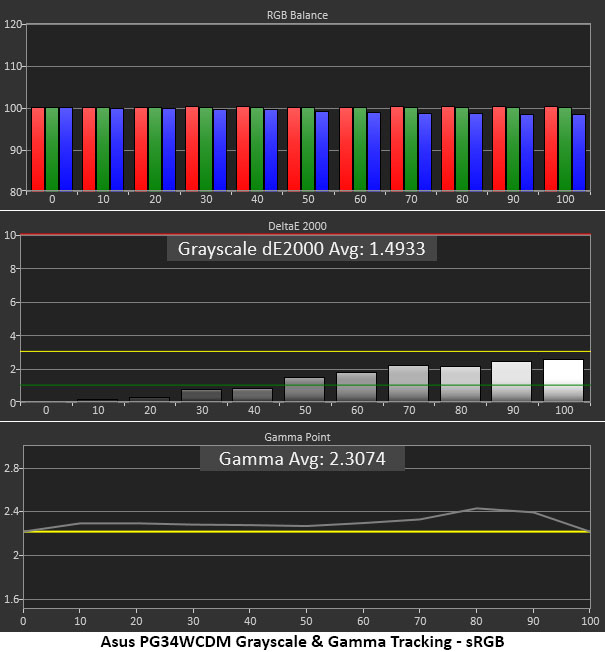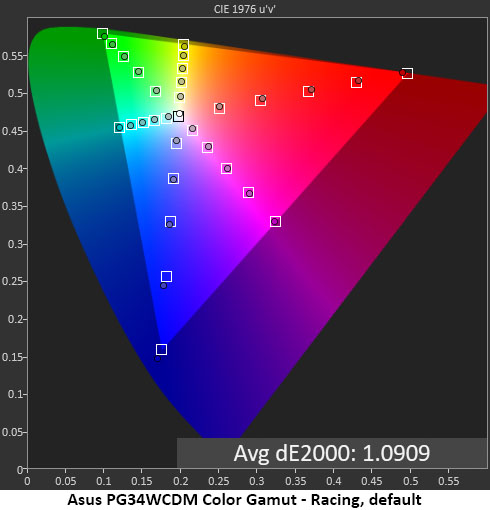Why you can trust Tom's Hardware
Like all Asus gaming monitors, the PG34WCDM comes out of the box in Racing mode. While the terminology could be more intuitive, this is almost always the best and most accurate preset. A calibration data sheet accompanies each sample, and I verified its values in my tests. The PG34WCDM does not need calibration, nor does it benefit from adjustment.
Grayscale and Gamma Tracking
Our grayscale and gamma tests use Calman calibration software from Portrait Displays. We describe our grayscale and gamma tests in detail here.



In the first grayscale chart, you can see no errors. All dE values are below 3, where they become visible. I noted a gamma anomaly, though. Luminance values from 70 to 90% are a bit low which makes highlights a little dark. It is a minor issue, but it does remove a bit of pop from the image. You can get that verve back by turning Uniform Brightness off. This makes it impossible to get a proper gamma measurement, but it does make the image more three-dimensional. You’ll have to lower the brightness slider to compensate.
Calibration improves the grayscale numbers a bit, not visibly but measurably. Gamma is unchanged. I also measured with the sRGB gamut selected and found similarly accurate results. Gamma is a bit darker overall with the same hump at 70-90%.
Comparisons




While I was able to reduce the PG34WCDM’s grayscale error from 1.47 to 0.98dE, this made no visual difference. You don’t need to calibrate in Racing mode. Gamma was more off the mark than the other screens, thanks to the issue I mentioned in the 70-90% brightness range. It’s a bit darker there than it should be. Again, if you see a problem, try turning Uniform Brightness off.
Color Gamut Accuracy
Our color gamut and volume testing use Portrait Displays’ Calman software. For details on our color gamut testing and volume calculations, click here.



I have zero complaints about the PG34WCDM’s color accuracy in the DCI-P3 and sRGB realms. It doesn’t get much better than this, even compared to professional screens, which cost much more. This is not a Quantum Dot monitor, but it nearly fills the green primary anyway. And every point is spot-on for both saturation and hue. Calibration makes no visible difference and delivers only a slightly lower dE value.
Get Tom's Hardware's best news and in-depth reviews, straight to your inbox.
The sRGB gamut option is perfect for photo work and color grading with a 1.22dE error that’s well below the visible point. Like DCI-P3, every point is correct for saturation and hue.
Comparisons


The PG34WCDM leads the group in DCI-P3 color accuracy with a 1.03dE score. Few monitors have measured better in my experience. It is completely qualified for professional use. You could put it in a post-production or pro graphics workflow without issue.
This is where the Quantum Dot layer makes a difference. QD-OLEDs have a little more color volume but the PG34WCDM is no slouch at 97.61% coverage of DCI-P3. In a side-by-side comparison, you’ll be hard-pressed to tell a difference unless the image has a lot of intense hues. For gaming, the PG34WCDM satisfies, and its accuracy gives it extra versatility.
Test Takeaway: Though the PG34WCDM doesn’t have as much color volume as a QD-OLED, the difference is minor. For gaming, it would not be a deal-breaker since it covers almost 100% of DCI-P3. And with no need for calibration, it is one of the most accurate OLEDs I’ve tested to date.
MORE: Best Gaming Monitors
MORE: How We Test PC Monitors
MORE: How to Buy a PC Monitor
MORE: How to Choose the Best HDR Monitor
Current page: Grayscale, Gamma and Color
Prev Page Brightness and Contrast Next Page HDR Performance
Christian Eberle is a Contributing Editor for Tom's Hardware US. He's a veteran reviewer of A/V equipment, specializing in monitors. Christian began his obsession with tech when he built his first PC in 1991, a 286 running DOS 3.0 at a blazing 12MHz. In 2006, he undertook training from the Imaging Science Foundation in video calibration and testing and thus started a passion for precise imaging that persists to this day. He is also a professional musician with a degree from the New England Conservatory as a classical bassoonist which he used to good effect as a performer with the West Point Army Band from 1987 to 2013. He enjoys watching movies and listening to high-end audio in his custom-built home theater and can be seen riding trails near his home on a race-ready ICE VTX recumbent trike. Christian enjoys the endless summer in Florida where he lives with his wife and Chihuahua and plays with orchestras around the state.
